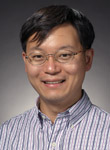
ENGINEER OF ARTIFICIAL COMPOUND BUG EYE
Bug eyed: Assistant Professor Jaeyoun Kim recently helped engineer artificial compound eyes, similar to the natural eyes of bugs. Each artificial eye contains thousands of ommatidia—a polymer microlens-waveguide complex each about the size of a pinpoint. The artificial eye can look in different directions and in all, contains more than 8,000 microlenses honeycombed on a curved surface the size of a pinhead.
Big breakthrough: Kim and three collaborators developed the artificial eye by dispensing drops of photopolymer in circular wells to make microlenses, and replicating it several times by dropping another type of polymer on top of it. Next, the researchers created a “self-writing” waveguide to connect the microlens to the photodetector where the image is captured and transmitted. Kim and his team are the first to make self-written waveguides with microlenses that are aligned automatically and adopt the waveguide-lens hybrid to mimic the compound eye structure.
Room to explore: Kim acknowledges that although they made a major breakthrough in this research area, they still were not able to completely simulate a compound eye. He says the main obstacle is getting the light to reach all the way to the photodetector and then to create one unified image. “There’s still a lot of room to explore,” he says.
Looking ahead: Although Kim plans to continue with this research, his next goal is to achieve real-time hemispherical imaging with commercially available detectors. Kim says he can see these artificial eyes being used for many things in the future. Doctors could use them to see inside the human body and study a blocked artery inside the heart. They also could be used in the military for counterterrorism efforts by planting a tiny aircraft inside a suspected terrorist’s cave. The aircraft could see practically everywhere at once.